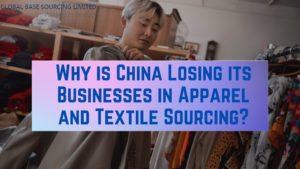Sourcing textile fibers in China has gotten increasingly complex in recent years. Many Chinese businesses avoid the clothing and textile sector. This poses an important question: why is China losing its apparel and textile sourcing business?
This blog post will discuss why Chinese companies are abandoning the industry? Whether its the rising labor costs or increasing competition from other countries. By exploring these factors and their implications, we will gain valuable insight into the current state of apparel and textile sourcing in China. Moreover, what do textile sourcing materials mean for the future?
What is Apparel and Textile Sourcing, and Why Has China Lost Its Edge?
Apparel and textile sourcing refers to the process of acquiring raw materials, fabrics, and textiles. Additionally, the use in the manufacturing of clothing, accessories, and home goods. This process involves locating and selecting suppliers and negotiating contracts. As well as ensuring that materials are delivered on time and meets quality standards.
China has been a dominant player in the apparel and textile sourcing market for many years, but it has recently started to lose its edge due to a combination of factors. Some of these factors include rising labor costs, increased competition from other countries, and trade tensions and tariffs. Additionally, shifts in consumer preferences towards more sustainable and ethically-made products have led some companies to re-evaluate their sourcing strategies and look for alternatives to China. Despite these challenges, China remains an important player in the Sourcing materials industry and continues to be a major supplier of textiles and apparel to the global market.
The Impact of Tariffs and Trade Wars on China’s Apparel & Textile Businesses
The trade war between the United States and China has significantly impacted China’s apparel and textile businesses. The US government imposed tariffs on Chinese imports, including textiles and apparel. As response to intellectual property theft and other predatory trade practices by China.
In retaliation, China imposed tariffs on US products worth $75 billion in two stages. The US responded by increasing the Section 301 tariff rate for products on lists 1-3 to 30% from 25%, as of October 1, 2019. Products on List 4A and 4B, worth $112 billion and $160 billion respectively, were also subjected to an additional tariff of 15% as of September 1, 2019, and December 15, 2019, respectively.
Despite the suspension of the additional 10% tariff on goods of sections 1 and 2 of Annex II from December 15, 2019, due to the US-China “Phase One” trade deal, the US President Biden announced in January 2021 that he would not remove the tariffs imposed by the previous president Trump on China in the short term.
China developed an action plan to strengthen intellectual property protection and end forced technology transfers. Furthermore, become ready to purchase $200 billion worth of US goods and services through 2021. The Chinese government also planned to reduce sliding tariffs on cotton cargoes imported under additional quotas to reduce the cost of importing cotton fiber into China.
According to a white paper from Greenberg Traurig’s Government Law & Policy practice, Biden’s trade view is more focused on multilateral action to resolve trade conflicts. However, the US must continue to take action against China by continuing the punitive tariffs on finished products. Along with other enforcement actions to address government subsidies, state-owned enterprises, forced labor practices and weak environmental standards. Moreover, with the intellectual property theft, and currency manipulation.
What Factors are Contributing to the Loss of Business for China in Apparel and Textile Sourcing?
There are several factors contributing to the loss of business for China in apparel and sourcing textile materials, including
- Tariffs and trade wars: The tariffs imposed by the United States and other countries have significantly impacted China’s apparel and textile businesses. The tariffs have made Chinese exports more expensive, reducing the competitiveness of Chinese products in the global market.
- Labor costs: The labor costs in China have been increasing, making it less attractive for international buyers to source from China. Additionally, the lack of labor mobility in China has made it difficult for businesses to access workers.
- Environmental regulations: The stricter environmental regulations in China have made it more expensive for textile and apparel businesses. In order to operate in the country, leading some companies consider alternative sourcing options.
- Intellectual property concerns: Some companies have been concerned about the protection of their intellectual property in China. Therefore, it leads to a reduction in the number of businesses sourcing from the country.
- Political instability: The ongoing political tensions between China and other countries have made some companies hesitant to source from China. Due to concerns about supply chain disruptions.
These factors have contributed to a decline in the competitiveness of China’s apparel and sourcing textile materials business. Consequently, it leads to a loss of business for the country in this sector.
In a Nutshell,
In conclusion, the loss of business for China in the apparel and textile industry can be attributed to a combination of factors. For instance – rising labor costs, trade wars, and tariffs. While these challenges are significant, it’s also important to note that some companies, like Global Base Sourcing Limited. Subsequently, they are actively seeking out alternative sourcing textile materials in other countries. This shift highlights the need for companies to adapt and remain competitive in a constantly evolving global market.
As the industry continues to change, it will be fascinating to see how companies like Global Base Sourcing Limited navigate these challenges. As well as, maintaining their position as leaders in the world of Sourcing textile materials.
The post Why is China Losing its Businesses in Apparel and Textile Sourcing? appeared first on The Digital Baba.


